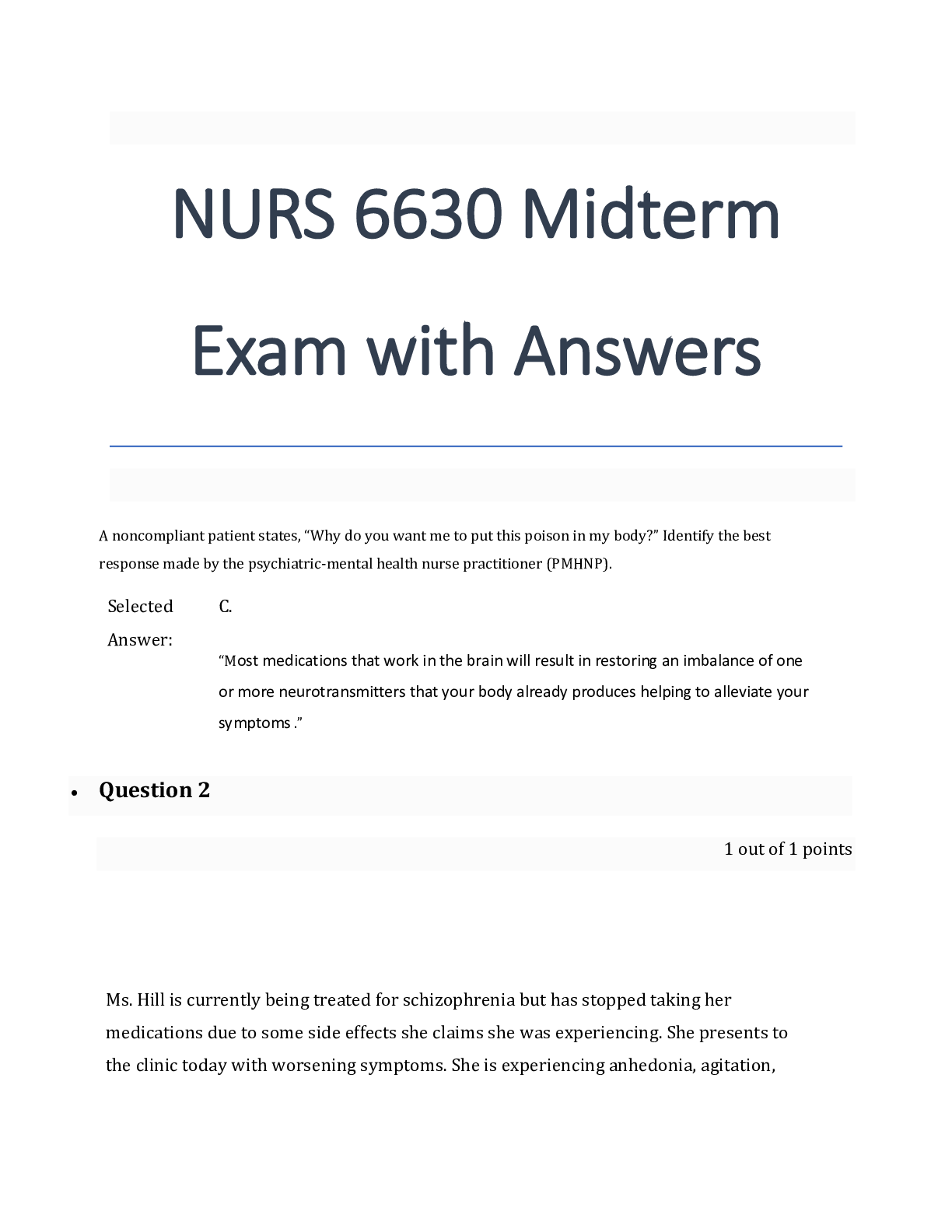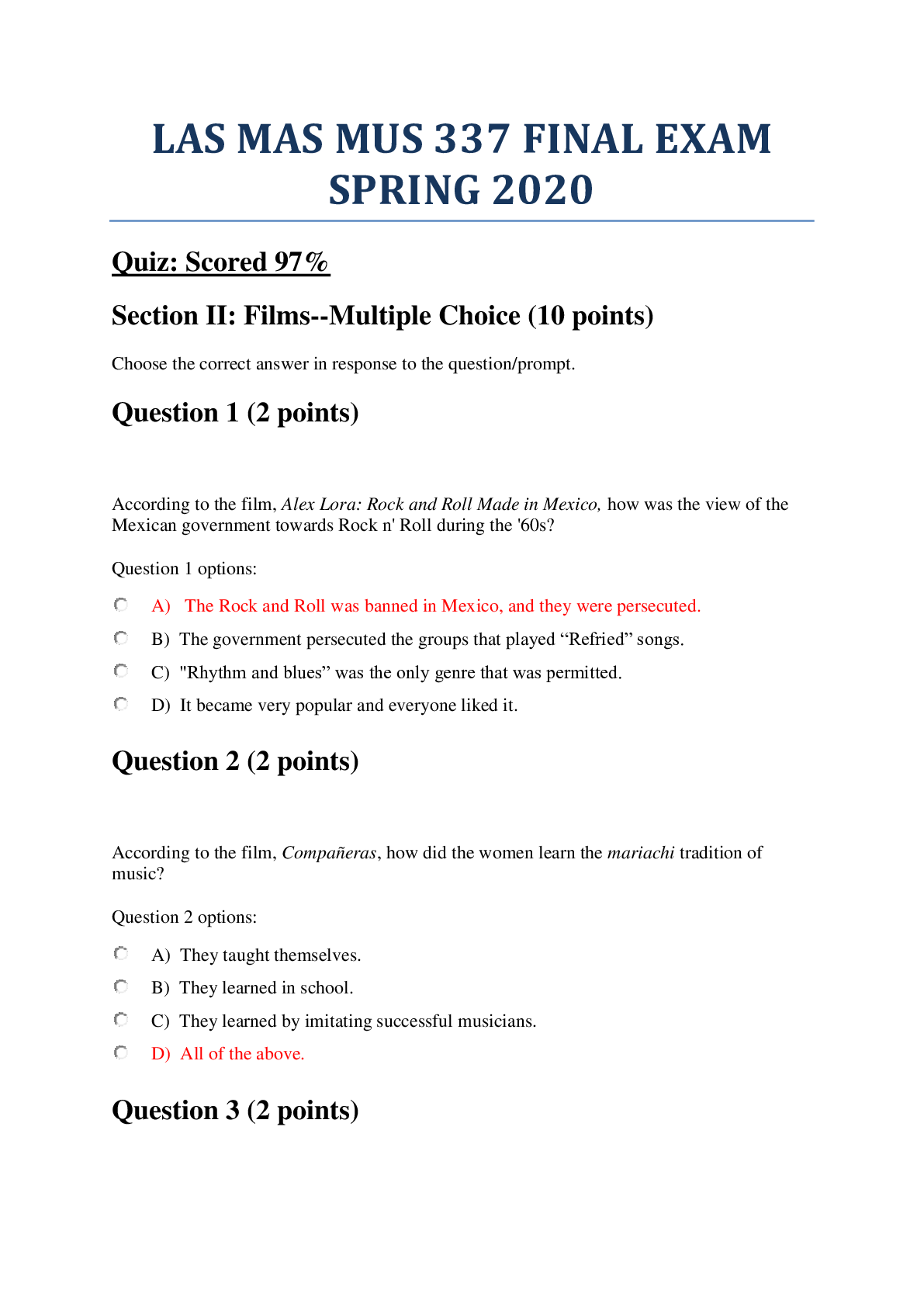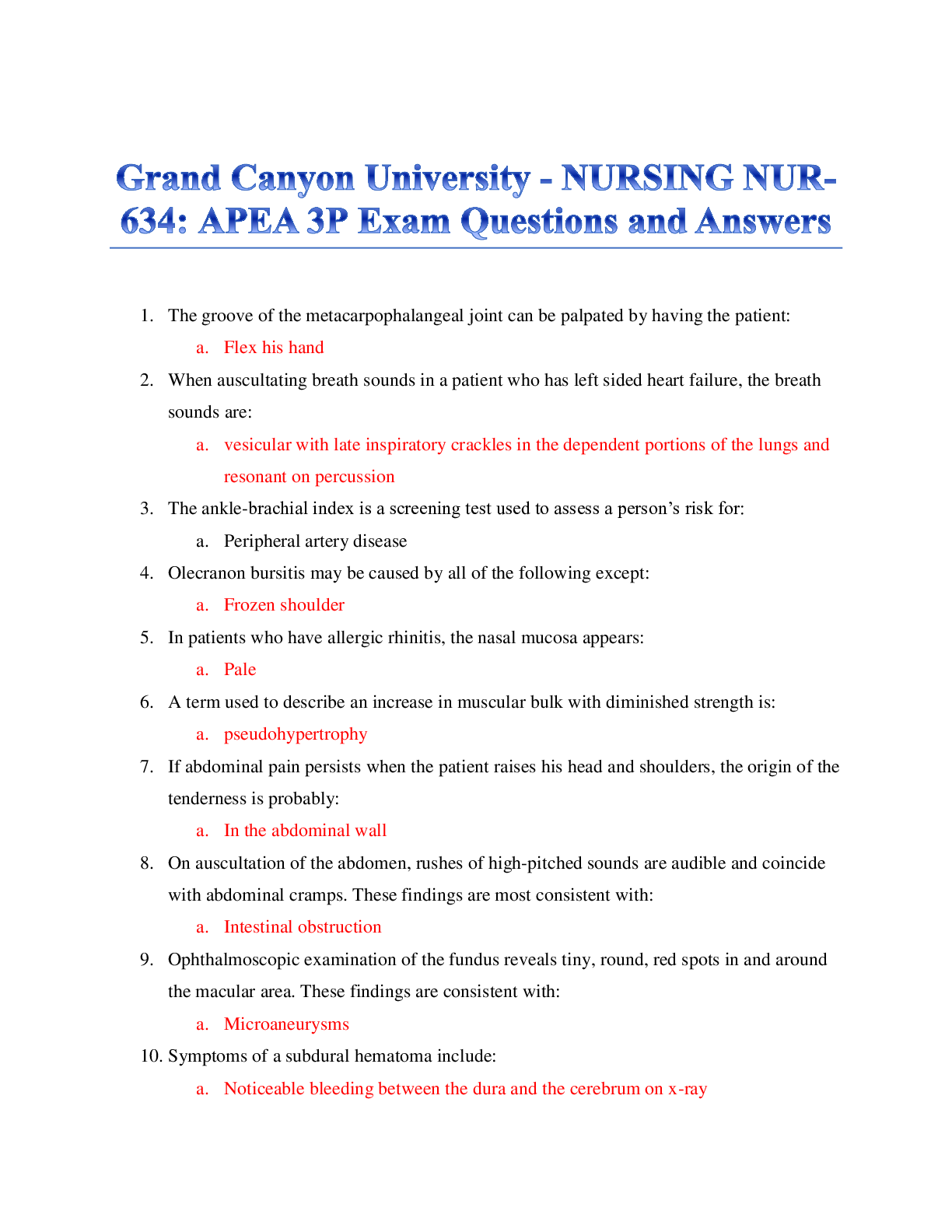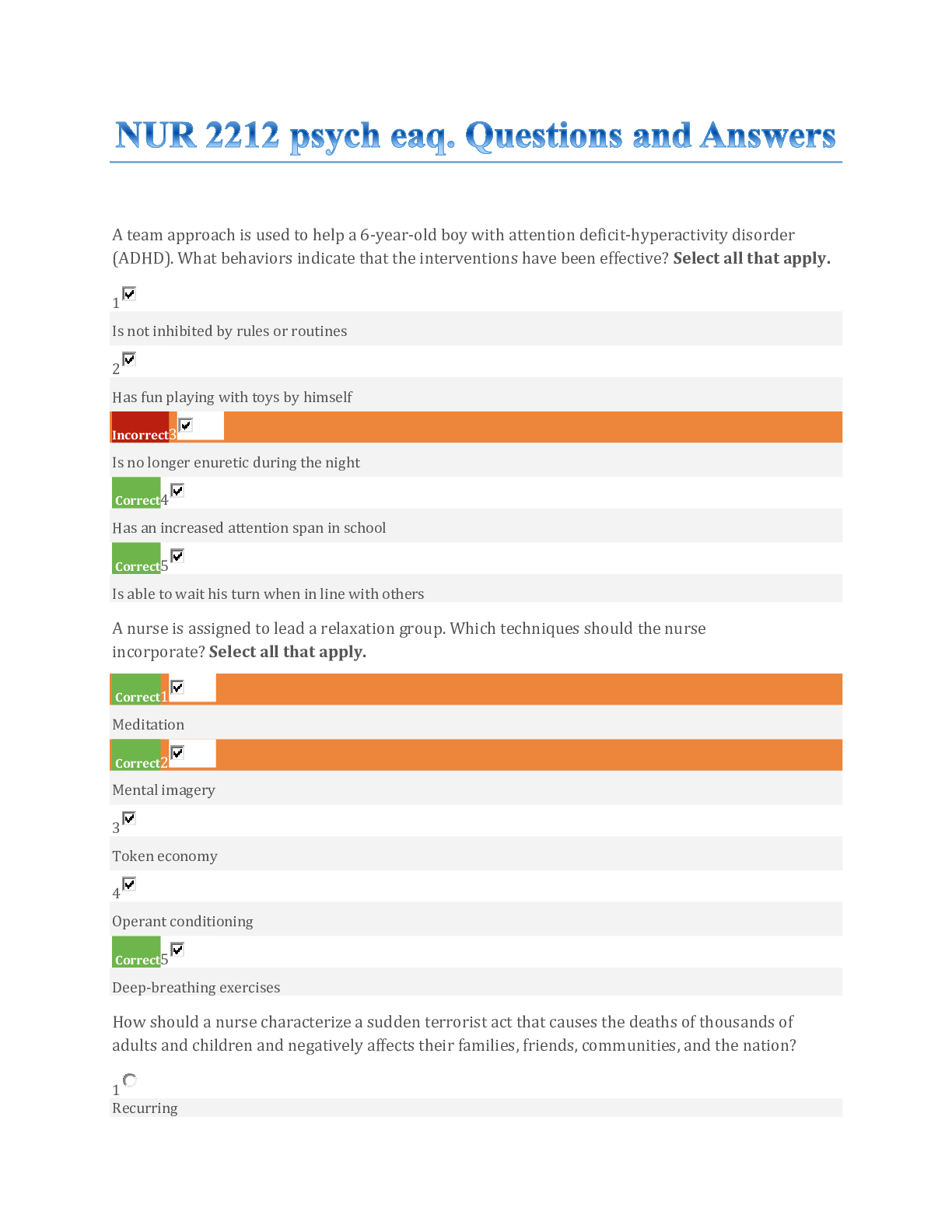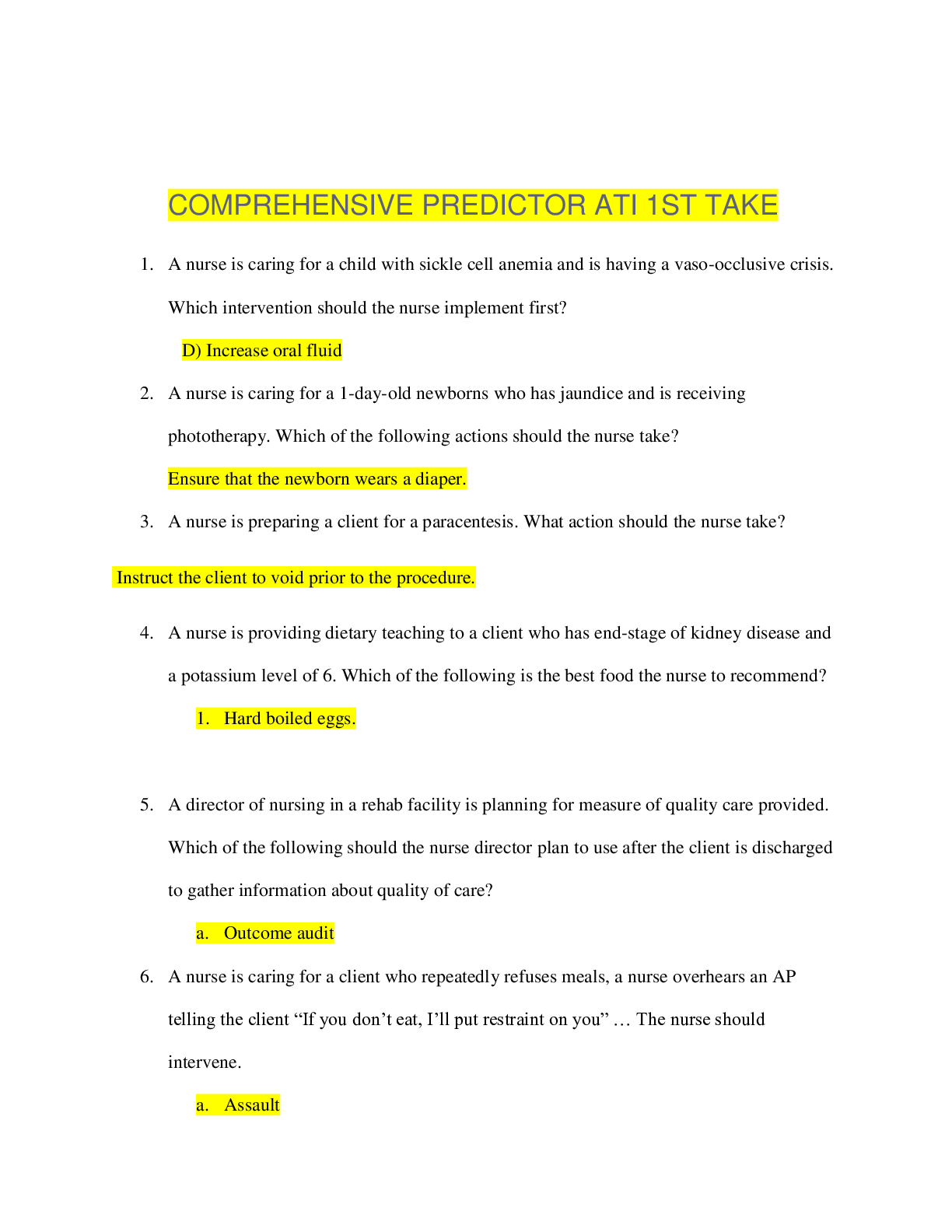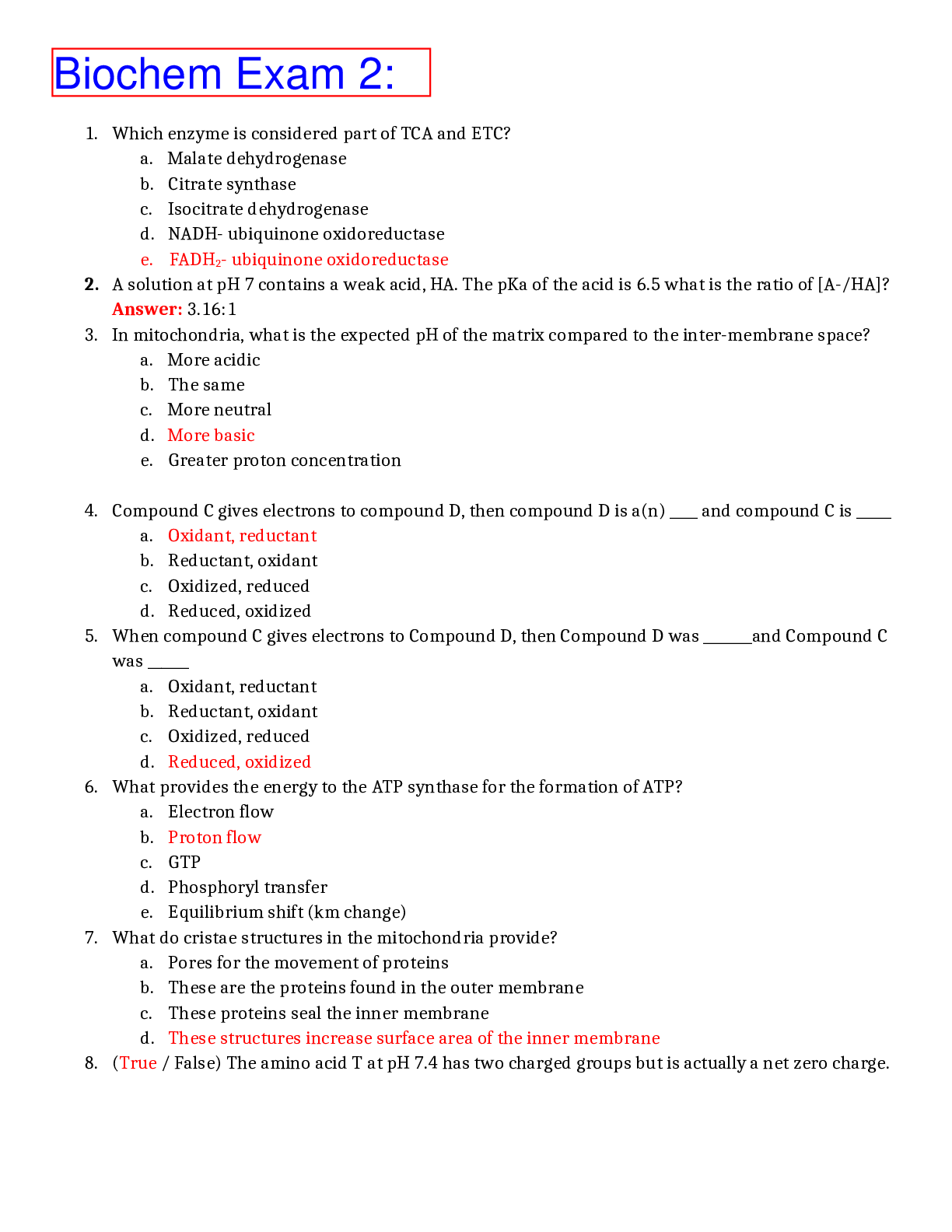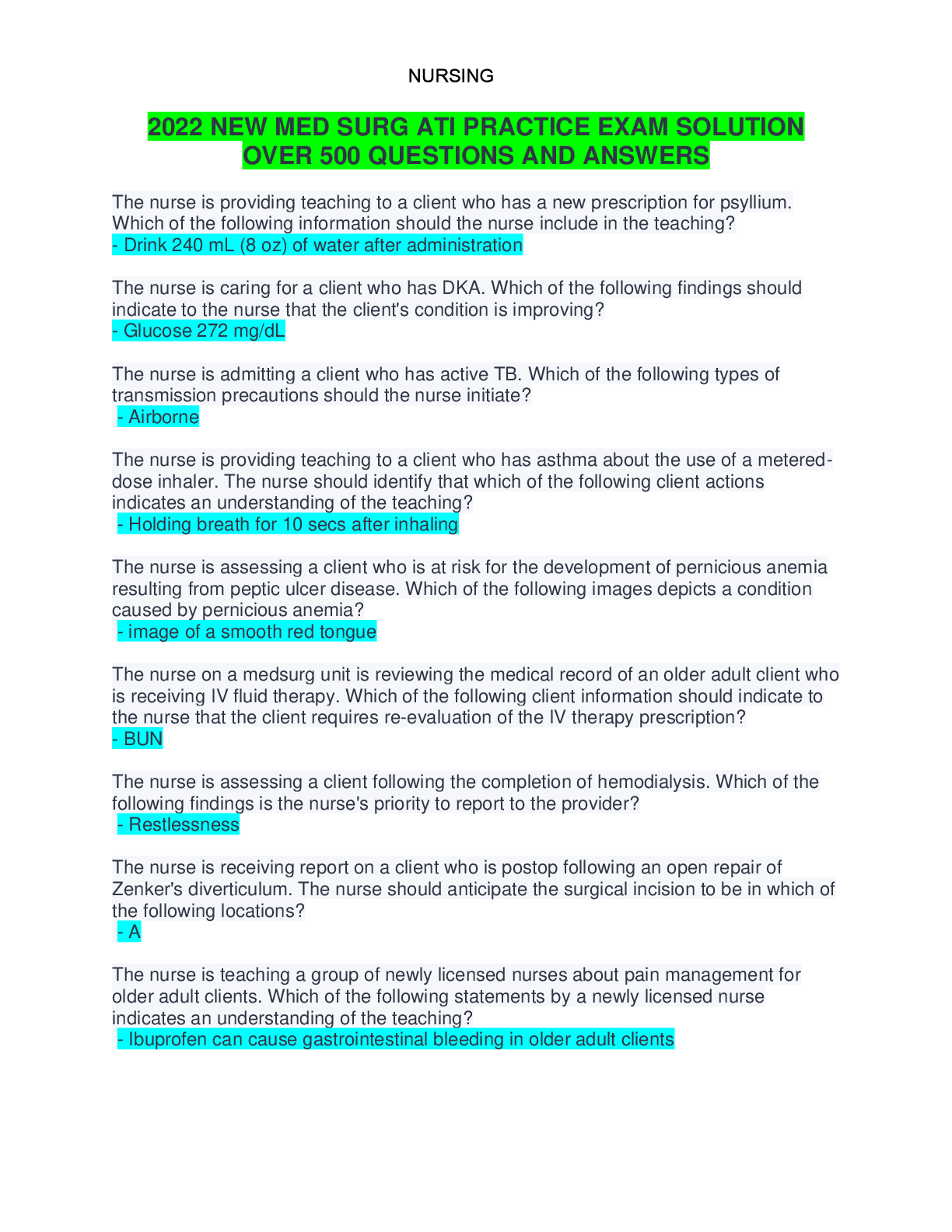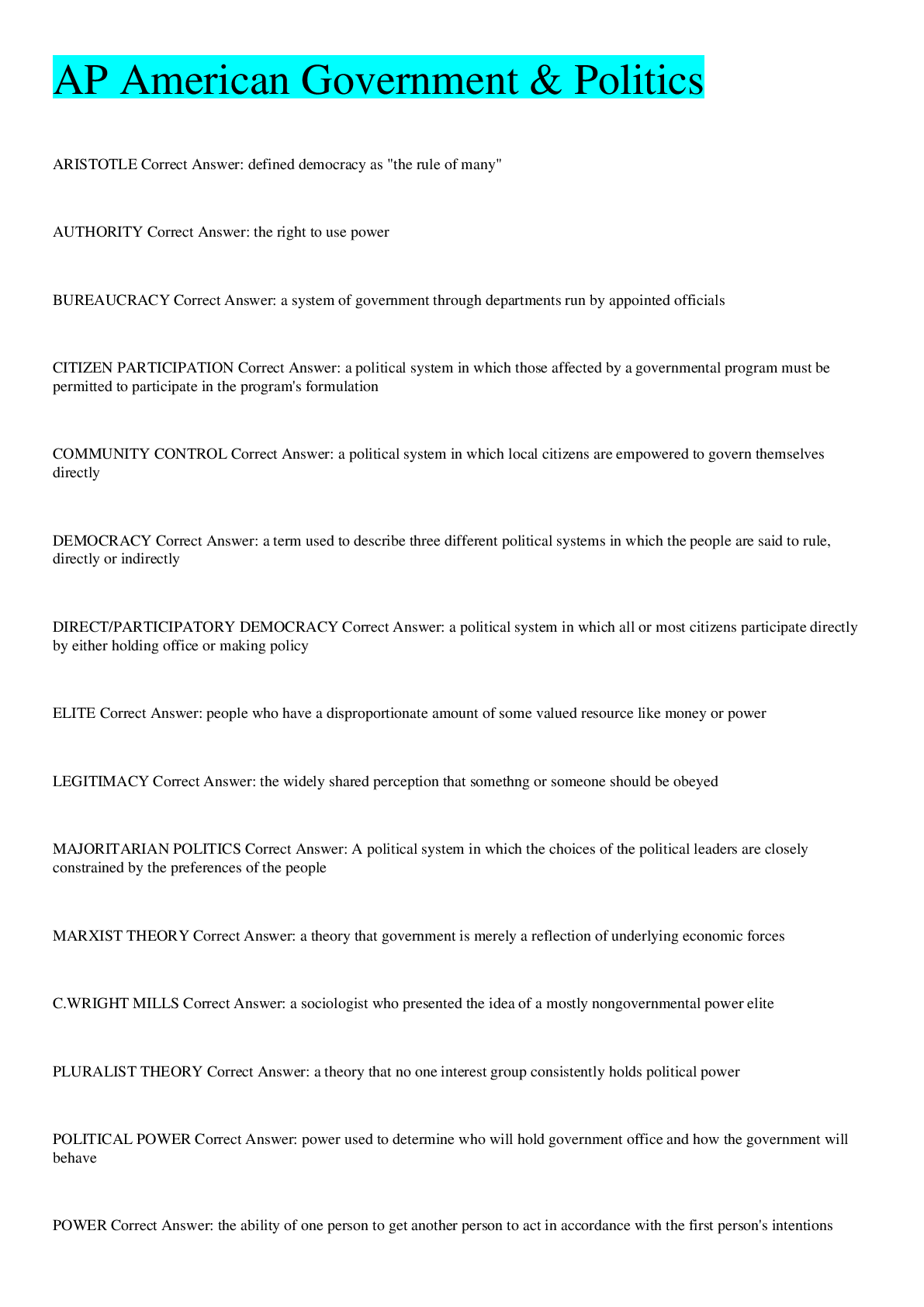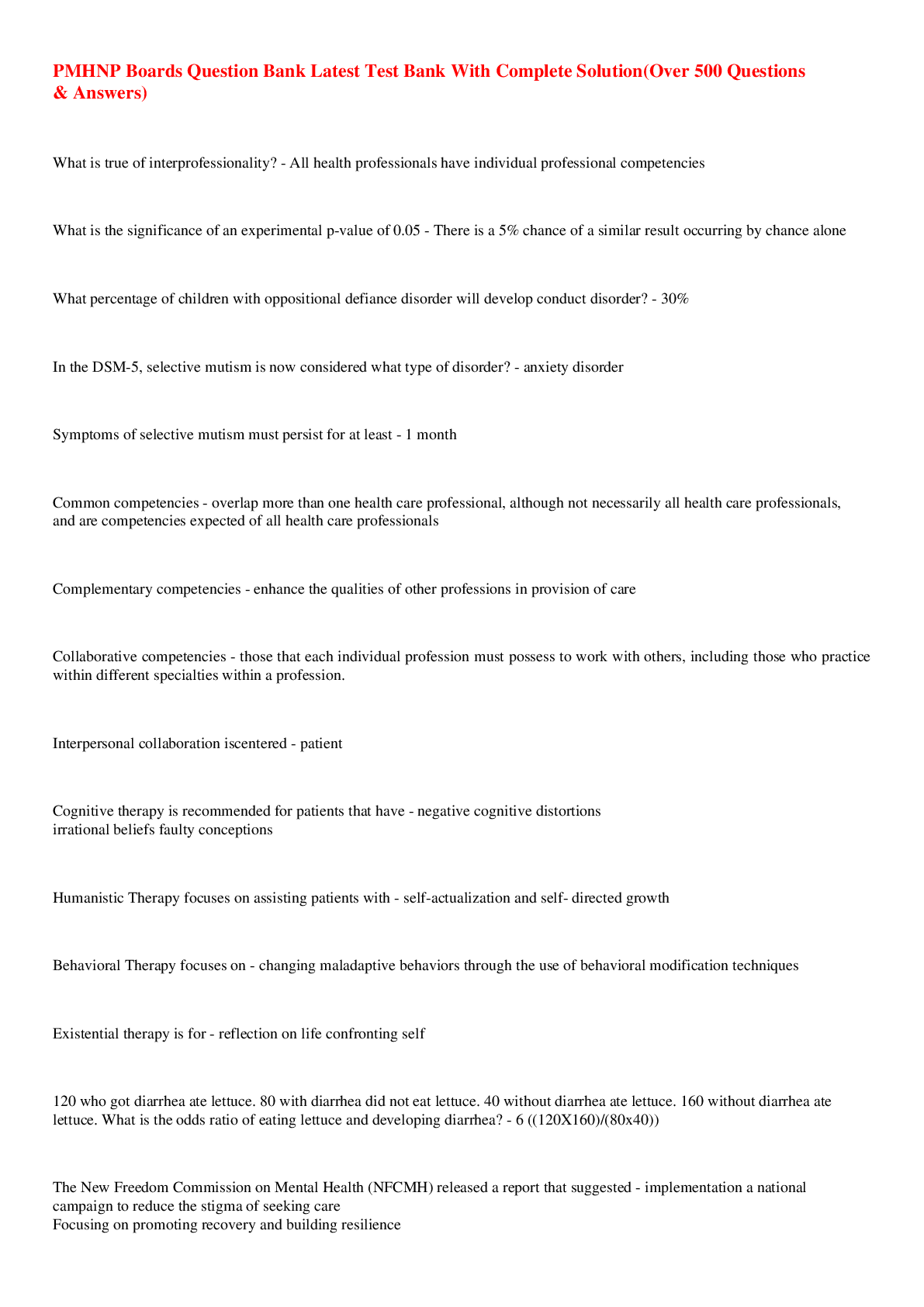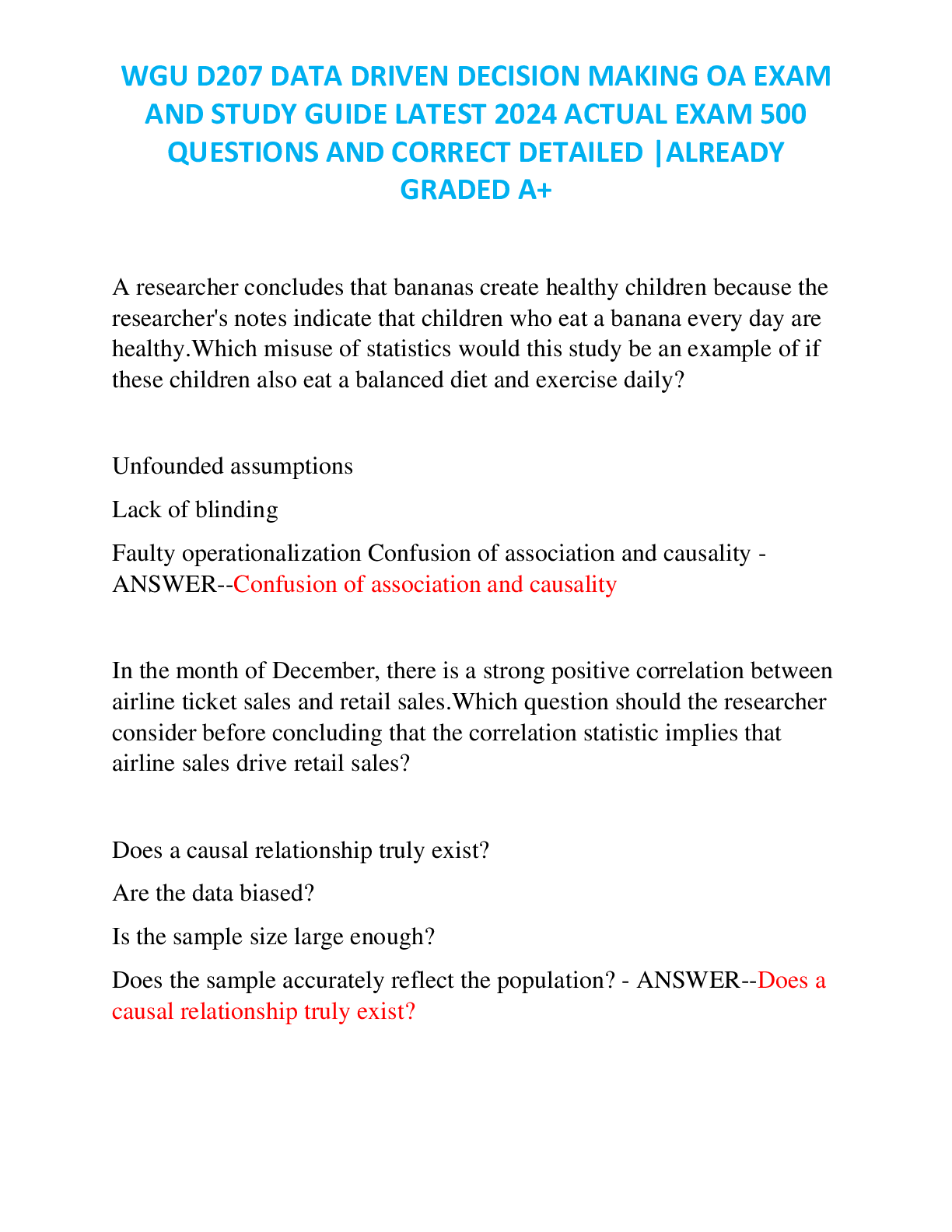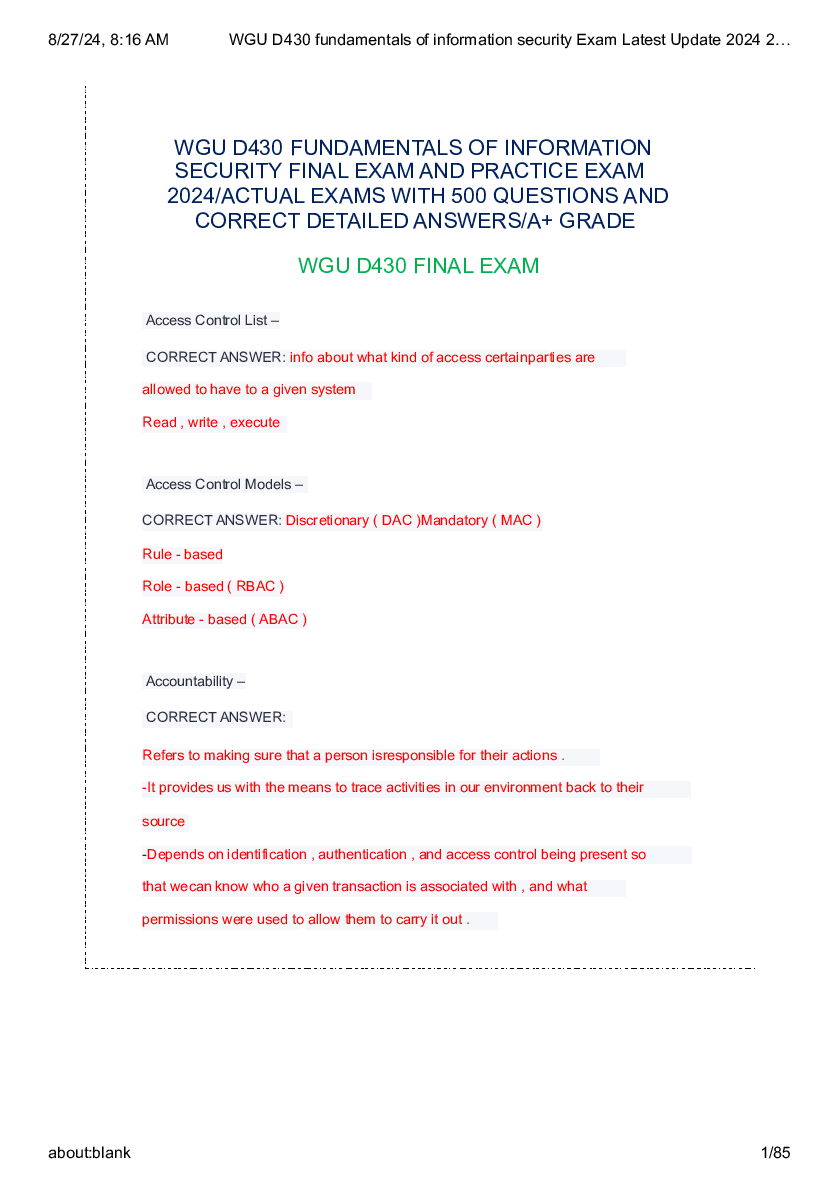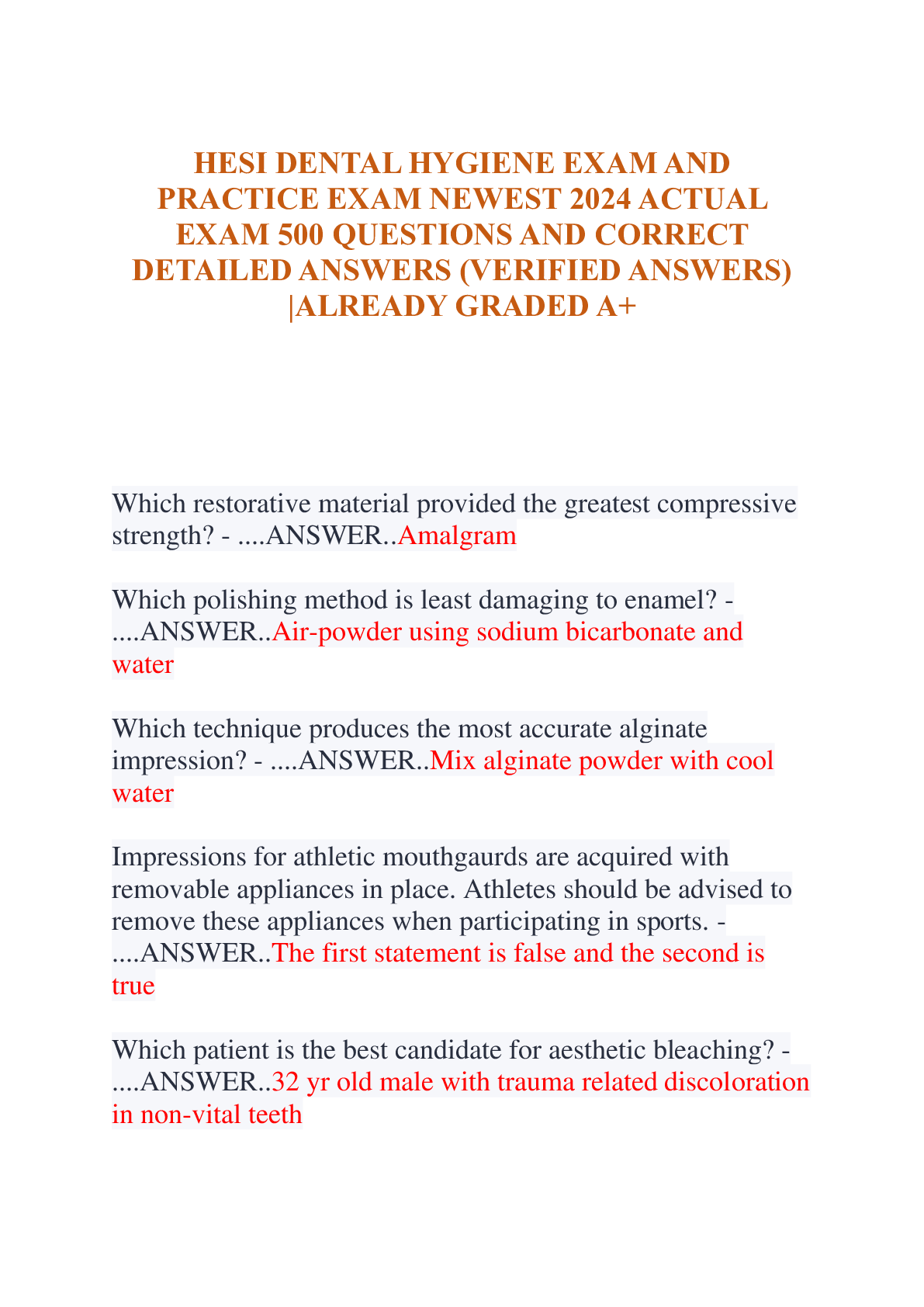Government > EXAM > George Mason University AP U.S. GOVERNMENT & POLITICS MULTIPLE-CHOICE QUESTIONS 2020-2022. Contains (All)
George Mason University AP U.S. GOVERNMENT & POLITICS MULTIPLE-CHOICE QUESTIONS 2020-2022. Contains More than 500 Questions and Answers.
Document Content and Description Below
SAMPLE QUESTIONS AND CHOICES 096190AP U.S. GOVERNMENT & POLITICS MULTIPLE-CHOICE QUESTIONS 2020-2021 Unit #1 – Foundations of American Government 1. Which of the following concepts is fundamenta... l to democracies? a. Economic equality b. Tyranny of the majority c. Majority rule with minority rights d. Bicameralism e. Seniority 2. Individuals have power when they are able to a. get elected to office. b. be present at behind-the-scenes political meetings. c. serve their fellow human beings. d. get others to do what they want them to do. e. vote without being influenced by outside forces. 3. Formal authority refers to a right to exercise power that is derived from a(n) a. official ceremony. b. majority vote. c. consensus. d. popular consensus e. governmental office. 4. Linkage institutions are mechanisms through which citizens can influence the policy agenda. All of the following are linkage institutions EXCEPT a. the Constitution b. political parties c. interest groups d. the media e. elections 5. The primary source of legitimate political authority in the United States is the a. Bill of Rights. b. will of the people. c. U.S. Constitution. d. concept of civil liberty. e. notion of civil rights. 6. Representative democracy allows individuals to gain political power through a. media campaigns. b. quadrennial elections. c. nonpartisan elections. d. reciprocal elections. e. competitive elections. 7. A city council representative faces an important vote on how much, if any, money to spend on a new school. The representative relies on a poll of her constituents to make a decision. This is in keeping with the form of politics known as a. participatory politics. b. majoritarian politics. c. pluralist politics. d. elitist politics. e. reciprocal politics. 8. Those who possess a disproportionate share of political power are defined as a. capitalists. b. majoritarians. c. a political elite. d. officeholders. e. centralists9. The pluralist view holds all of the following EXCEPT a. No single elite has a monopoly on political resources. b. Policies are the result of a complex pattern of shifting alliances. c. Political resources are not distributed equally. d. Political elites are divided. e. Political elites do not respond to the interests of their followers. 10. According to Tocqueville, egalitarianism in the United States involves a. self-interest. b. moral precepts. c. religious commitment d. economic equality for all classes e. equality of opportunity in the absence of a monarchy 11. Which of the following accurately characterizes the main difference between elite theories and pluralist theories of politics in the United States? a. Elite theories concentrate on the role of interest groups; pluralist theories emphasize the role of individuals. b. Elite theories argue that a single minority dominates politics in all policy areas; pluralist theories argue that many minorities compete for power in different policy areas c. Elite theories argue that social status is the major source of political power; pluralist theories argue that wealth is the major source. d. Elite theories emphasize the multiple access points that interest groups have to public officials; pluralist theories stress the limits in the number and effectiveness of such access points. e. Elite theories view government as efficient; pluralist theories view it as slow and wasteful. 12. In our society, government officials should be accountable to the people. This principle is known as a. liberty. b. equality. c. civic duty. d. democracy. e. capitalism. 13. Liberty and individualism are two key elements of a. all Western democracies. b. all twentieth-century nations. c. most nations throughout history. d. U.S. political culture. e. European nations in the 1700s. 14. Hyperpluralists differ from pluralist in their belief that a. the representation of too many interests is detrimental to policymaking b. only the wealthiest lobbyists are heard in Congress c. power should be centralized in one branch of government d. competition among groups leads to compromise and, hence, stronger policy e. political groups get their funds exclusively from big business 15. All of the following are basic elements of the U.S. political culture EXCEPT a. liberty. b. populism c. individualism. d. laissez-faire e. economic equality.16. Which one in each of the following pairs are Americans more likely to tolerate? a. political as opposed to economic inequality b. ideologues as opposed to activists c. economic as opposed to political inequality d. activists as opposed to ideologues e. political as opposed to sociological inequality 17. Religious diversity in the United States was largely the result of the absence of a(n) a. powerful army. b. bill of rights. c. strong central government. d. established aristocracy. e. established religion. 18. The notion that individuals should work hard, save their money, and avoid dependence on the state is sometimes referred to as the a. Protestant (work) ethic. b. blue-collar ethic. c. doctrine of social Darwinism. d. evolutionary principle. e. labor theory of value. 19. Some people argue the culture war is about a. which ethnic group governs. b. what kind of country we ought to live in. c. how much money should be spent on social programs. d. the ethics of foreign policy. e. which groups deserve to influence policy. 20. In recent decades, what has been the relationship between public confidence in political institutions and that in other institutions? a. They have both gone down. b. The former has gone down while the latter has remained unchanged or declined. c. The former has remained steady while the latter has gone down. d. The former has gone up while the latter has gone down. e. Both have remained quite steady. 21. If people have a sense of political efficacy, then they believe they a. trust the government to do what is right. b. would rather live here than elsewhere. c. are capable of joining interest groups. d. feel alienated from public policy. e. have a say in what government does. 22. Which of the following theories claims that too many competing groups cripple government’s ability to govern? a. hyperpluralist theory b. pluralist theory c. elite theory d. democratic theory e. class-based theory 23. Which of the following principles is most fundamental to democratic theory? a. free elections and universal suffrage b. minority rule c. universal public education d. political parties e. a written constitution24. According to traditional democratic theory, all of the following are characteristics of an ideal democracy EXCEPT a. freedom of speech b. a written bill of rights c. equality of voting d. citizens have collective control over the government’s policy agenda e. government extends rights to everyone who is subject to its laws 25. The following functions are shared by all governments EXCEPT a. maintaining a national defense b. ensuring social equality c. preserving order d. providing public services e. socializing the young 26. On which of the following indicators of democratic health does American democracy do poorly? a. Political equality b. Majority rule c. Minority rights d. Voter turnout e. Freedom of speech 27. According to pluralists, a wealthy interest group would a. have more access to policymakers b. compete with other interest groups for an equal share of influence c. buy all of the votes on a piece of legislation d. manipulate public opinion to support legislation proposed by Congress e. have no influence on the policy agenda 28. The most recent immigrants to the United States have tended to come from a. Central America and Asia b. southern and eastern Europe c. northern and western Europe d. the former Soviet Republics e. the Middle East and Scandinavia 29. Which of the following statements most accurately summarizes the figure on the next page? a. The gap in political knowledge between the young and the old has narrowed between 1972 and 2008 b. While political knowledge has decreased for all age groups between 1972 and 2008, the decrease has been the largest for younger Americans c. In 1972 the young were considerably more politically knowledgeable than the elderly; in 2008 the elderly were considerably more politically knowledgeable than the young d. Older Americans are more likely to vote than younger Americans e. The advent of cable television and the Internet helps explain why Americans were more politically knowledgeable in 2008 than they were in 1972.30. How are older Americans different from younger Americans? I. Older Americans are more likely to vote. II. Older Americans are increasingly resistant to taxes. III. Older Americans are more supportive of investing Social Security funds in the stock market. IV. Older Americans are less likely to favor spending money on government health and social welfare programs. a. III only b. I and II only c. I, II, and III only d. II, III, and IV only e. I, II, and IV only 31. The U.S. is expected to have a “minority majority” population by 2050. What does this mean? a. Hispanic Americans will outnumber the Caucasian population b. Female conservatives will outnumber male conservatives c. Asian Americans will outnumber Hispanic Americans d. Voters under the age of 30 will outnumber senior citizens e. The minority populations will collectively outnumber the Caucasian population 32. Which of the following is NOT one of the modern challenges to democracy, as described in the textbook? a. Escalating campaign costs b. Increased complexity of issues c. A global economy d. Limited participation in government e. Diverse political interests 33. Examples of direct democracy include programs of citizen participation and a. interest group participation. b. guerrilla warfare. c. competitive elections. d. political party centralism. e. community control over decision-making6 34. All of the following were considered to be “swing states” in 2012 EXCEPT a. Virginia b. Nevada c. Ohio d. Florida e. Texas 35. All of the following demographic trends will confront the U.S. in the 21st Century EXCEPT a. Racial diversity is growing. b. The number of senior citizens is decreasing. c. The number of African Americans serving in elected office has increased. d. Much of the American population growth since World War II has been centered in the West and the South. e. Asian Americans have begun to achieve political success. 36. The adversarial, contentious spirit of U.S. society is related most closely to Americans' belief in a. individual rights. b. social equality. c. group harmony and cohesion. d. democracy. e. bicameralism. 37. One of the ways in which the culture war differs from other political disputes is that a. compromise is almost impossible. b. money is a critical issue. c. it is exclusively about what kinds of policies the government ought to adopt. d. the issues are basically simple ones. e. it has no distinct winners or losers. 38. A city council representative faces an important vote on how much, if any, money to spend on a new school. The representative relies on a poll of her constituents to make a decision. This is in keeping with the form of politics known as a. participatory politics. b. majoritarian politics. c. pluralist politics. d. elitist politics. e. reciprocal politics. Unit #2 – Political Ideology and Participation 1. Which of the following statements about the gender gap is the most accurate, according to the text? a. Men have “deserted” Democratic candidates for Republican ones. b. The gender gap has remained constant in the past four elections. c. Women voters tend to identify more strongly than men with the Republican party. d. Most analysts agree about the electoral significance of the gender gap. e. Men have “deserted” Republican candidates for Democratic ones.7 2. The general pattern of public-opinion/political cleavages in this country has been a. horizontal, based on class. b. vertical, based on many variables. c. vertical on economic issues and horizontal on social issues d. impossible to analyze clearly. e. cross-cutting, based on many variables. 3. In polling, a random sample is one that a. is generated by a computer using complex algorithms. b. gives each person an equal chance of being in the sample. c. has no preselection criteria. d. just happens, with no control by any outside force. e. perfectly matches the population 4. Given a sampling error of 3 percent, if 47 percent of respondents say they will vote for George W. Bush, we can infer that a. between 44 percent and 50 percent of the voters will vote for Bush. b. the likelihood of 47 percent voting for Bush is 97 percent. c. 3 percent of the respondents are falsifying their intentions. d. Bush will lose the election narrowly 97 times out of 100. e. None of the above 5. Which statement most accurately describes the party loyalties of African-Americans? a. They are generally Republican. b. They are generally Democrats. c. They are overwhelmingly Democrats. d. They are overwhelmingly Republican. e. They are usually independents. 6. Among the following groups, the group that is most likely to hold political views that are similar to Anglo-whites are a. blacks. b. Hispanics. c. Asian-Americans. d. Latinos. e. Mexican-Americans 7. Voters in the South have become progressively less attached to a. the Democratic party. b. the Republican party. c. liberal ideology. d. conservative ideology. e. independent parties. 8. A coherent and consistent set of beliefs about who should rule and how is referred to as a. political efficacy. b. public opinion. c. pragmatism. d. realism.8 e. political ideology. 9. All of the following statements concerning Americans' ideological thinking are correct except a. Most Americans describe themselves as liberal. b. Only a small minority of Americans take ideologically consistent views on political issues. c. People often express opinions at odds with the ideological label they attach to themselves. d. Ideological thinking may be greater in some years than in others. e. A plurality of Americans classify themselves as moderate. 10. Today, a conservative would be more likely than a liberal to oppose a. a strong military presence abroad. b. deregulation of airlines. c. restrictions on a woman’s right to abortion. d. a tax increase. e. the death penalty .1 1. Today, a liberal would be more likely than a conservative to oppose a. the death penalty. b. a reduction in defense spending. c. school busing to achieve desegregation. d. legalizing marijuana. e. raising taxes, especially on the rich. 12. Although rising in recent elections, voter turnout in U.S. presidential elections is typically a. less than 25 percent. b. less than 30 percent. c. less than 70 percent. d. approx. 80 percent. e. nearly 100 percent. 13. Political participation encompasses all of the following activities except a. voting. b. paying your taxes. c. writing your congressional representative. d. signing a petition. e. watching a political debate. 14. One way the "motor-voter" bill makes registering to vote easier is by allowing a. mail-in registration with income tax payment for all car owners. b. registration with driver's license application. c. all state welfare offices to register applicants. d. automatic registration for all car owners. e. rewards for car owners who register. 15. One way that blacks were prevented from voting prior to passage of the Voting Rights Act of 1965 was by requiring them to a. meet qualifications found in Article III of the Constitution. b. register six months in advance of an election. c. become U.S. citizens. d. memorize the Bill of Rights.9 e. pass a literacy test. 16. Between 1915 and 1925, the size of the eligible voting population in the United States almost doubled. The main reason for this was that a. the Fifteenth Amendment to the U.S. Constitution was ratified. b. women were given the right to vote. c. the grandfather clause that denied voting to blacks was ruled unconstitutional. d. literacy tests for blacks were ruled unconstitutional. e. voter registration laws were abolished in seventeen states. 17. Suffrage was extended in the Twenty-sixth Amendment to a. those aged eighteen to twenty. b. blacks. c. women. d. residents of the District of Columbia. e. felons who had received presidential pardons. 18. The steady decline in U.S. voter turnout during the late twentieth century appeared to be the unintentional result of a. strict voter registration procedures. b. the poll tax. c. the fraudulent reporting of election results. d. literacy testing. e. media campaigns. 19. Most of the states that initiated same-day voter registration (on Election Day) have experienced a. a continuing voter turnout decline. b. a major increase in voter turnout. c. no change at all in voter turnout. d. a major increase in turnout of Democratic voters. e. some improvements in voter turnout. 20. Politically inactive individuals tend to be all of the following except a. low income. b. ideological. c. young. d. nonwhite. e. A and B. 21. The most powerful determinant of political participation, other than education and information, is a. race. b. gender. c. employment. d. region e. age. 22. Which of the following generalizations about group voting tendencies is true?10 a. Jewish voters tend to vote Republican b. Protestant voters tend to be more liberal than Roman Catholic on economic issues c. More women than men identify themselves as Republicans d. Rural voters are more likely to support Democratic candidates than are urban voters e. African American Democrats tend to support the more liberal candidates within their party 23. Political socialization is the process by which: a. the use of private property is regulated by the government b. governments communicate with each other c. public attitudes toward government are measured and reported d. political values are passed to the next generation e. children are trained for successful occupations 24. When 18 to 21 year olds received the right to vote in 1971, in the 1972 national elections they did which of the following? a. Voted overwhelmingly for Republican candidates b. Voted overwhelmingly for Democratic candidates c. Voted overwhelmingly for radical candidates d. Turned out at a lower rate than the rest of the electorate e. Turned out at the same rate as the rest of the electorate 25. The most common form of political activity undertaken in the United States is: a. lobbying to influence decisions by public officials b. campaigning for candidates for office c. contributing money to a political party d. voting in local elections e. voting in presidential elections 26. Which of the following is an accurate statement about the voter turnout rate in the United States: a. It is high because of the large numbers of elective offices b. It is significantly higher among men than among women c. It is lower than in most other Western democracies d. It increased sharply when eighteen year olds were given the right to vote e. It has been steady over the last 30 years 27. Political elites/activists are a. always conservative in their views b. always liberal in their views c. usually more ideological than are average citizens d. usually more optimistic about the future of the country than are average citizens e. usually supporters of minority rights 28. Which of the following best describes the relationship between socioeconomic status and participation in politics? a. The lower one’s socioeconomic status, the more likely it is that one will run for public office b. The higher one’s socioeconomic status, the greater the probability of active involvement in the political process c. Adults who are unemployed have a greater personal interest in policy and tend to participate more11 actively in politics than do employed adults d. People in the lower middle class are the most likely to participate in politics e. There is no relationship between socioeconomic status and political participation 29. Moderates fall to the ____________on the political spectrum a. right b. far left c. left d. center e. far right 30. “Voting is partly a matter of habit: the more frequently a person has voted in the past, the more likely she or he is to vote in the current election.” All of the following support the observation above EXCEPT: a. Immediately after the Twenty-Sixth Amendment in 1971 gave 18-to-21 year olds the vote, the proportion of eligible voters who actually voted declined b. Immediately after the Nineteenth Amendment in 1920 gave women the vote, the proportion of eligible voters who actually voted declined c. Immediately after the passage of the Voting Rights Act of 1965, the participation rate of Black voters in the South was lower than that of White voters in the South d. Unmarried persons over the age of 65 are less likely to vote than are married persons in that age group e. Newly naturalized citizens may need special inducements to vote 31. Which of the following is an accurate statement about political participation in the United States today? a. a majority of Americans campaign for a candidate in each presidential election b. Over 75% of Americans vote in presidential elections c. People who participate in the political process are usually angry at government d. Similar proportions of eligible men and women vote in presidential elections e. People in their thirties or forties are less likely to be active in politics than are those aged 18 to 21 32. A powerful national government is likely to meet opposition in which of the following regions of the United States? I. South a. I and IV II. Northeast b. II and III III. Midwest c. I and II IV. West d. I, II, and IV e. I, II, and III 33. What did George Gallup mean when he said that public opinion polls “speed up the process of democracy” in the United States? a. Laws will always move quickly through the legislative process if public opinion supports them b. Polls can cue politicians to consider important political issues c. Public opinion polls accurately predict election outcomes so the public actually knows the winners months in advance12 d. All politics is driven by public opinion e. Polls can make elections run more smoothly 34. Which of the following is an example of a survey that uses self-selection? a. A sports Web site asks readers to vote for which NBA team LeBron James should play b. Some surveys ask questions only to Ferrari owners c. A poll asks if people had a good day, giving them “yes” and “no” as options d. A poll was conducted with the responses of only 10 respondents being measured e. A polling firm calls 1,000 people randomly to ask them a question about presidential approval 35. Convicted felons are allowed to vote a. in certain states, depending on the state law b. never c. by constitutional mandate d. as long as they did not commit murder e. ten years after leaving prison 36. According to recent trends, which of the following people would be MOST likely to vote? a. An eighteen-year-old college freshman because she just became eligible to vote b. A male when Hillary Clinton was running for the Democratic presidential nomination c. A father whose family receives welfare because he sees the direct benefits of government d. Donald Trump because he sees the direct financial consequences of his decision e. An African-American male because he sees few candidates like him in office 37. How are older Americans different from younger Americans? I. Older Americans are more likely to vote II. Older Americans are more conservative III. Older Americans are more supportive of investing Social Security funds in the stock market IV. Older Americans are more likely to favor spending money on national defense a. III only b. I and II c. I, II, and III d. II, III, and IV e. I, II, and IV 38. Suffrage is most likely to be formally denied to a citizen who is a. African American b. disabled c. 18 years old d. a convicted felon e. a pauper 39. Which of the following statements help to explain why voter turnout is lower in the United States than in most other democracies? I. Citizens in other democracies vote more often and, therefore, have developed stronger voting habits II. Citizens in most other democracies are required by law to vote13 III. Citizens in most other democracies are not required to register themselves to vote IV. Citizens in most other democracies face starker differences between the viable political parties a. I and II b. I and III c. II and III d. II and IV e. III and IV 40. Individual opinions sometimes may be badly informed and unstable: a. but aggregate public opinion is both stable and coherent. b. which leads to an uninformed and unstable aggregate public opinion. c. though only informed and stable individual opinions are considered for the purposes of aggregate public opinion. d. but when combined into aggregate public opinion they are informed – though still unstable. e. which makes discussing public opinion on a given issue useless. 41. On which of the following issues do the opinions of men and women generally differ most? a. Abortion rights. b. Equal roles for women and men in society and politics. c. The use of violence in foreign and domestic policy. d. Social welfare spending. e. Campaign finance reform. Questions 42 and 43 refer to the graph. 42. Which of the following statements is reflected in the data in the chart? a. Those who are younger are more likely to be registered to vote than those who are older. b. Among registered voters, there was a steep increase in social media usage to follow political figures across all age groups and party affiliations. c. Registered voters in the 65+ age group did not increase their use of social media to follow political figures. d. Of those using social networking sites, those registered as Republican were more likely to vote than those registered as Democrats.14 43. Which of the following is a potential consequence of the trend illustrated in the bar chart? a. Social media has led to more candidates running as independents rather than as members of political parties. b. Elected officials and candidates running for office are increasingly using social media to reach out to voters and constituents. c. Social networking sites such as Facebook or Twitter have been overrun with political content. d. Social networking sites have led to increased political polarization in the general public. 44. Which of the following is an accurate comparison of conservative and liberal views concerning social policy? Conservative Liberal a. The federal government should have a stronger role in shaping education The federal government should provide more funding for public schools b. Licensed gun-owners should be permitted to openly carry firearms in public The federal government should not conduct background checks for gun purchases c. Racial and gender considerations should be taken into account to promote diversity in workplace hiring decisions Job promotion should be based on skills and experience, not race or gender d. Individuals should not rely on government aid for their economic well-being The government should be responsible for helping to improve the economic position of low-income people Unit #3 – Electoral Process 1. Party identification among voters is one way of gauging strength of a party. Another way of gauging strengh is the a. number of parties that appear on the ballot in a national election b. use of a party label or symbol on ballots in municipal elections c. strength of the organization that recruits and campaigns for candidates d. protection offered to individual parties by the U.S. Constitution e. amount of attention given to parties by the media [Show More]
Last updated: 2 years ago
Preview 1 out of 45 pages

Buy this document to get the full access instantly
Instant Download Access after purchase
Buy NowInstant download
We Accept:

Reviews( 0 )
$14.00
Can't find what you want? Try our AI powered Search
Document information
Connected school, study & course
About the document
Uploaded On
Mar 29, 2022
Number of pages
45
Written in
Additional information
This document has been written for:
Uploaded
Mar 29, 2022
Downloads
0
Views
120

